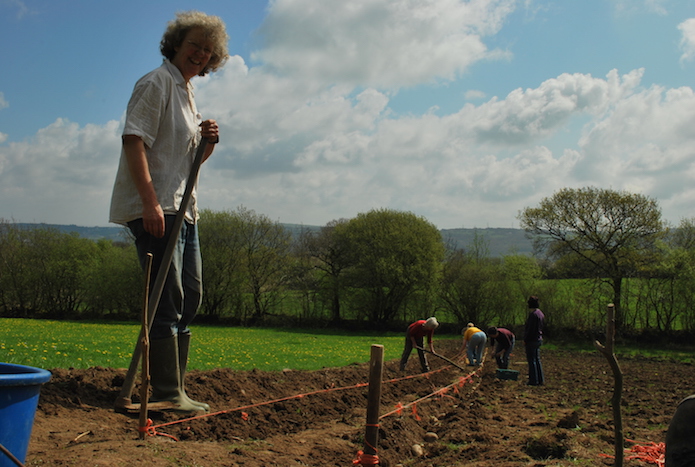By Tony Matthews.
There are two beautiful river valleys in Carmarthenshire, South West Wales, the Gwendraeth Fawr and the Gwendraeth Fach, separated by the Carboniferous Limestone ridge which surfaces all around the South Wales coalfield. The two rivers join by Kidwelly castle then flow into Carmarthen bay.
Ty`r Eithin farm, 80 acres in all, looks down into the Gwendraeth Fawr where a series of villages along the river owe their existence to outcrops of very high quality anthracite which was mined and used , amongst other things, for the smelting of tin for the tin plate works in Kidwelly or for carting up to the limestone kilns behind us. The Gwendraeth Fawr is now effectively an ex-industrial valley.
Our wetter fields, where the carboniferous shales surface, boast a unique marshy grassland vegetation which includes whorled caraway (now adopted as an emblem for Carmarthenshire), marsh lousewort, bog asphodel, bog bean, devil`s bit scabius (host for the rare marsh fritillary butterfly) and a host of different willows, ferns, sedges and mosses. Our small fields include some on drier ground lying above sandstone where eyebright and yellow rattle thrive and where hay or haylage can be made to feed our Welsh Black and Belted Galloway cattle when they are indoors to rest the fields in winter.

Also at home here are all the local Amphibia and Reptiles, including black adders well adapted to our cloudy climate, as well as small mammals, even pole cats seen sometimes. Bird life is sadly simplifying as in most parts of the UK, and we no longer hear the curlew, the peewit nor, in the last two years, the grass hopper warbler and the barn owl, the latter suffering as it does from excessive rainfall. Believe me, they have been missed.
One of the reasons we know so much about our wildlife is because we are members of Llanelli Naturalists, a group of dedicated experts and amateurs who are joyfully knowledgeable about our natural heritage albeit also deeply concerned about its ongoing demise, the latter by no means unconnected with industrial farming systems which, even in this area, are taking over more and more land. Llanelli Naturalists arrange farm, woodland, SSSI and coastal walks led by our in house experts.
The produce of Ty`r Eithin, Biodynamic more than 25 years, is our own beef sold in freezer ready 10Kg packs, vacuum packed in clearly labelled, family size portions . Also freezer ready whole and half lambs. In the last four years we have also been reaching out to our local community by starting a CSA fruit and vegetable scheme, aiming for between 40 and 50 members this year.
Over a twenty year period we have worked intensively with local agencies to get cattle grids in place so that Mynydd Llangyndeyrn, our local common which straddles the limestone ridge between the two valleys, can be grazed again. Several thousand years of continuous communal grazing was interrupted when modern conditions, essentially speeding cars and lorries on the road across made grazing too hazardous.

Ty`r Eithin`s 80 acres of marginal land has become a hub of local interest, local and international volunteering and a focus for good local food and conservation while along the valley the owners of two different but similarly wildlife rich farms are keen to ensure their land can be taken on in a sustainable way once they retire.
Could this be the scenario in which to plant the foundation for a renewed relationship between rural people and our land base? While they all include key wildlife habitats, each of the three farms is uneconomic in terms of farm production but they could be run together as complementary cooperative units, sharing equipment, and some skilled manpower. By maintaining and adding to existing housing, the three could indeed take on some aspects of a Camphill community by integrating special needs as we already do at Ty’r Eithin, though relying far less on state funding. By working with volunteers and professionals to produce high quality food for local people and providing best practise for nature conservation work, could we emulate as a co-op the landed estates of old, each with its own unique complement of land, people and a developing culture of the arts and craft activity specifically generated in relation to this land? Would such a set up become dynamic enough to create a polar balance to the exciting city culture, of which Britain is so rightly proud?
People are needed, funding is needed, to make this a viable replicable model. Can we even dream of an estate of several thousand acres, including part of both valleys, straddling the limestone ridge and the common, all of it a new generation of common land owned and managed for itself and for all those concerned nearby and further afield, growing arable, dairy, beef and vegetables, woods, permaculture, with dance, music, literature, art and craft? Could this relatively impoverished part of West Wales become the cradle for a much saner co-operative approach to rural living?
To finish I cannot leave out language, for both our valleys have retained their Welsh. Indeed, the Gwendraeth Fawr is the only valley in the South Wales coal field to have done so. It is largely a practical, down to earth Welsh, readily taught in the vegetable field, the creamery, the bakery, the woodwork shop or pottery. Let`s sing to it!
Tony Matthews farms at Ty`r Eithin, Dyfed, South Wales.
If you are thinking about succession planning for your farm, do have a look at our page on Caring for Your Land in Perpetuity.

Published by